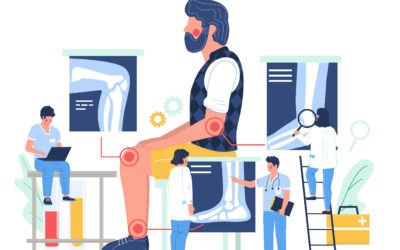With warm weather approaching, and spring ads from Home Depot and Lowes depicting beautiful outdoor landscaping, many people are motivated to get out to their yards and clean up a winter season’s worth of dead plants and overgrowth. However, much like a yard that has been minimally tended to during the cold months, many people forget their bodies may not be conditioned to tolerate a major yard make-over in one weekend.
In our clinic, it is not unusual to see an increase in tendinitis flare-ups in shoulders or elbows from hours of pruning, nagging neck or back pain that turns into major pain from trying to lift heavy pots/ bags of dirt or digging all day, or if the yard is on a hill, knee pain from walking up/down hill repetitively. Even if you are a dedicated exerciser, without the awareness of good postural control or acknowledging that a certain body part with prior injury is starting to become compromised, an injury can occur. So, if you are inspired to transform your yard this spring, here are some tips to protect your body.
Body Mechanic Awareness
When our joints, nerves and muscles are repetitively placed under end range stretch or compression, we are asking for trouble.
An example of this would be someone who repetitively bends over through their waist to pick weeds, plant flowers/vegetables or to dig. As they bend forward the ligaments and muscles in their lower back are put on stretch again and again so that micro trauma can start to occur; their disc pressure goes up which places them at higher risk for a protrusion/herniation injury; and their sciatic nerve is placed on stretch repeatedly which could lead to leg pain, numbness or tingling depending on the health of the nerve.


A squat or single leg squat with good form keeps the spine in neutral range with less stress to disc pressure and does not place the sciatic nerve at stretch. Many people do squats for 10 reps with medium to big weight for maybe 2-3 sets, but yard work is much longer than 2-3 sets. So, to train awareness and not fatigue into bad form we have our exercise classes develop the strength, endurance and mindfulness to be able to squat their body weight for possibly up to 3-5 minutes.
Even if someone is on their knees, but their hands are not supporting their body weight as they’re flexed forward risks injury to the ligaments, muscles and discs of the low back. So to do fine motor tasks like drip line or sprinkler repair, we recommend work on hands and knees or knees and forearms.
Similarly, in the upper extremity and neck if someone is doing work for prolonged periods of time at shoulder level or overhead the tendency is to round the shoulders, slump the head forward and shrug their shoulder blades if their arm muscles are becoming tired. When this happens the muscles of the rotator cuff are placed in an impingement pattern that leaves them at risk for tendinitis, the discs in the mid cervical spine are compressed and the nerves that innervate the arm from the neck are compressed due to poor neck position and elevated scapulae.


To train the upper half to develop the strength and endurance for yard work, we would recommend endurance work for rotator cuff muscles while keeping the neck in a neutral position, and practicing proper scapular control and avoiding end range shoulder motion which could risk impingement of the joints, muscles and nerves.
Lastly, remember to move your feet! Many times, when people are weed whacking, sweeping, raking or hoeing, the tendency is to plant the feet and just move the arms so all the motion of rotation and flexion is done at the back. If your arms go forward, take a step forward; as you pull back, take a step back. If you are moving your arms from side to side, make sure to pivot your feet with your hands so the rotation happens through the hips not just the spine.
Bracing Against Leverage
Many people are aware of keeping their tissues healthy when the task they have to do is within easy reach of their arms. Often in yard work, nothing is within easy reach. One may find themself side bent at an awkward angle trying to prune a bush near the fence line, reaching forward and ahead of their feet because they cannot step closer to the object they are working on, or trying to stabilize their trunk and arms against the weight of an electric hedger or weed whacker if they have to reach forward.
The common issue with all of these examples is the weight of the upper half of the body is reaching beyond the base of support (the feet) of the lower body. In order to keep the spine in a neutral position, the muscles of the neck, shoulders, trunk, and hips must brace 50-100% harder than they normally would, and again the person must have the mindfulness to know if they should stop an activity because their muscles are too fatigued to maintain control, thus placing the body at risk for injury.
Besides awareness of body mechanics, one must have the awareness of what it feels like to brace their muscles as they near end range in order to maintain control and when that control is lost, how to correct their form. As peoples’ tissues allow, we ask our exercise class participants to challenge themselves to push into tissue strain to feel their proprioception develop in these weaker ranges. Meaning, it is more important to move thoughtfully and be mindful of what stresses are being placed on the body and how to counteract those stresses than to just do a bunch of repetitions to say you completed an exercise.
Working Smarter, Not Harder
Exercise, body mechanics and body sense are all great tools to help combat against injury, but so is acknowledgement of body parts that are prone to injury. In my case, I have a back that can be injured if I grow too fatigued and fail to keep my posture in good position. If I think the task that I will be doing may be greater than my ability to keep my back safe, I use a back brace to help with reminding me to not cheat in my form and to add stability to my ligaments. If you know you are prone to elbow or wrist tendinitis due to older joints or cranky muscles, then it would be wise to use a wrist brace or elbow support if you plan on all day pruning or trying to lift shovelfuls of dirt to not over stress sensitive tissues.

Taking rest breaks from a known aggravating activity to help pace your body is also an option. For example, if digging for 2 hours most likely will cause your back to flare up, then dig for 1 hour, recover by doing a lighter task like sweeping, hosing off your deck, or blowing off the driveway at nice easy pace, and then try to finish the digging task when the muscles have had time to recover. I can personally attest that I do not like stopping a task once I have started, but I can also attest that when my back is letting me know continuing for another hour could catch up with me by the evening, no task has ever been worth the pain I have experienced when I do not listen to my body.
Lastly, if you know you have body parts which are prone to injury from overuse, ice them when the task is done. Rarely does a repetitive injury make itself known as you are doing the task, it’s one to two hours after you have stopped moving that the pain arrives. When you are done with a task in the past that has created an issue for your shoulder, neck, elbow, back, knee, etc., ice that body part for 10-15 minutes 2-3x before heading to bed. You are trying to stop the inflammatory cycle before it grows into a bigger problem which can take longer to heal.
Hopefully this information has been helpful to preventing a few injuries this spring. At Folsom Physical Therapy we believe in proactive training, not just reactive management, to promote healthy living. Our profession is movement specialists, meaning we have the most comprehensive knowledge for understanding the different physiologic stresses placed across muscles, joints, discs, and nerves, as well as how these interactions change depending on an individual’s health needs.
If you would like more information on how to protect a body part(s) before beginning a large outdoor, or indoor project, we would be happy to help give you the tools to keep your body safe. Just call (916) 355-8500 to set up an appointment.










